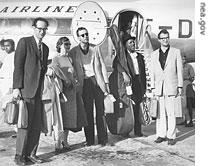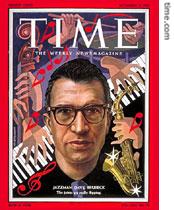VOA慢速英语 2008 0428b
时间:2018-12-07 作者:英语课 分类:VOA慢速英语2008年(四)月

Jazz musician Dave Brubeck
Welcome to THIS IS AMERICA in VOA Special English. I'm Barbara Klein. This week on our program, we enter the world of jazz pianist Dave Brubeck. His group had the first jazz album to sell more than a million copies.
(MUSIC)
"Time Out," released in nineteen fifty-nine, also gave the world one of the best-known jazz tunes 2 of all time. Written by saxophone player Paul Desmond, this is "Take Five."
(MUSIC)
This year is the fiftieth anniversary of another important event for the Dave Brubeck Quartet. In nineteen fifty-eight, the government sent the four musicians on a trip as part of a jazz ambassadors 3 program.

Dave Brubeck (far right) and band arrive in India in 1958
They performed across Europe. They also played in Afghanistan, Pakistan and Ceylon (now Sri Lanka), as well as India, Iran, Iraq and Turkey.
The two-month trip provided new ideas. For example, seeing the Berlin Wall that divided Germany led Dave Brubeck to write "Brandenburg Gate."
(MUSIC)
Earlier this month, Dave Brubeck accepted a special award from the State Department for that trip and others he made later. Secretary of State Condoleezza Rice presented him with the first Ben Franklin Award for Public Diplomacy 5.
She thanked him for representing America by bringing the language, the sounds and the spirit of jazz to people around the world.
(MUSIC)
The language of jazz includes hot jazz and cool jazz. Dave Brubeck is known for the cool kind. Jazz expert David Baker 6 at Indiana University says cool jazz emphasizes the melody 7 and is very relaxed. Professor Baker says hot jazz speaks to the heart; cool jazz speaks to the mind.
Here is an example from the Dave Brubeck Quartet, "In Your Own Sweet Way."
(MUSIC)
Jazz performers like to create as they play. This improvisation 8 adds to the written music they bring with them. This is why the same piece can sound different each time the same musicians play it. David Baker says the written music is the subject of the piece. The improvisation is the explanation.
Jazz musicians may also change the traditional grouping of rhythms in a piece. This is especially true of Dave Brubeck's music. Much of it is written in unusual time signatures.
Traditional jazz pieces are written for dancing, with four beats to a measure. This means that the same four beats are played over and over again. Here is an example of this four-four time, the Dave Brubeck Quartet playing "The Duke":
(MUSIC)

Dave Brubeck Quartet at Carnegie Hall in 1963
Now, an example of an unusual time signature can be found in a piece called "Eleven Four." It was written by Paul Desmond, who also wrote "Take Five." "Eleven Four" has eleven beats to a measure. Dave Brubeck himself explained it at a concert at Carnegie Hall in New York in nineteen sixty-three.
DAVE BRUBECK: "We'd like to do this tune 1 because of the title, 'Eleven Four.' You can guess that it's in eleven-four time. It was written by Paul. Again, the writing is very difficult, but that's not the problem. The problem is to improvise 9 in eleven -- which we let Paul do mostly on this thing."
(MUSIC)
One of the quartet's greatest hits is in still another unusual time signature. "Blue Rondo a La Turk," written by Dave Brubeck, is in nine-eight time.
(MUSIC)
Dave Brubeck attended the College of the Pacific in Stockton, California. At first he studied with the aim to become a veterinarian. But his mind was clearly on music; during college, he played in jazz clubs at night. He graduated in nineteen forty-two with a music degree.
He served in World War Two. The Army sent him to entertain the troops in Europe.
In nineteen forty-seven, in San Francisco, he joined a jazz band where he met Paul Desmond. Desmond played the alto saxophone. He became a member of the Dave Brubeck Quartet when Brubeck formed the group in nineteen fifty-one. The quartet became known for playing what was called West Coast cool jazz at local colleges.
In nineteen fifty-four they recorded "Jazz Goes to College," their first album for Columbia Records. It sold more than one hundred thousand copies and made the group nationally known. The album included their version of "Take the A Train," written by Billy Strayhorn for Duke Ellington.
(MUSIC)

Time magazine cover in 1954 honoring Dave Brubeck
Also in nineteen fifty-four, Dave Brubeck was on the cover of Time magazine. The story said he was responsible for a "new kind of jazz age in the U.S." It described his music as "some of the strangest and loveliest music ever played since jazz was born."
In nineteen fifty-six, drummer Joe Morello and bass 4 player Eugene Wright joined the quartet. The changes led to the group's most popular record, "Time Out," in nineteen fifty-nine. In addition to "Take Five," the album included "Three to Get Ready."
(MUSIC)
In nineteen sixty-seven the Dave Brubeck Quartet broke up. Dave Brubeck continued to write many different kinds of music -- classical symphonies 10, ballets and religious songs. The father of six also worked with his four grown children who became jazz artists.
Today, at the age of eighty-seven, Dave Brubeck still composes and performs. He also heads the Brubeck Institute at the University of the Pacific.
The institute houses a collection of more than sixty years of his recordings 11 and photographs. It also trains young musicians and works for social issues.

Dave Brubeck
On the Institute's Web site is a message from Dave Brubeck. He says he always sought the acceptance and recognition 12 of jazz as a serious art form. Jazz reflects "American ideals of freedom and individual expression balanced with group responsibility and interdependence," he says.
And he adds that once, when asked how he would like to be remembered, he answered, "As someone who opened doors."
(MUSIC)
Our program was written by Nancy Steinbach and produced by Caty Weaver 13. I'm Barbara Klein, hoping you can join us again next week for THIS IS AMERICA in VOA Special English. For transcripts 14, MP3s and podcasts of our programs, go to voaspecialenglish.com.
- He'd written a tune,and played it to us on the piano.他写了一段曲子,并在钢琴上弹给我们听。
- The boy beat out a tune on a tin can.那男孩在易拉罐上敲出一首曲子。
- a potpourri of tunes 乐曲集锦
- When things get a bit too much, she simply tunes out temporarily. 碰到事情太棘手时,她干脆暂时撒手不管。 来自《简明英汉词典》
- Kennedy, greatly admiring, rated him very high among his ambassadors. 肯尼迪十分赏识他,在所有大使中对他评价很高。
- Many countries were represented by their ambassadors at the Independence Day celebrations. 庆祝美国独立纪念日时,许多国家都派其大使代表参加。
- He answered my question in a surprisingly deep bass.他用一种低得出奇的声音回答我的问题。
- The bass was to give a concert in the park.那位男低音歌唱家将在公园中举行音乐会。
- The talks have now gone into a stage of quiet diplomacy.会谈现在已经进入了“温和外交”阶段。
- This was done through the skill in diplomacy. 这是通过外交手腕才做到的。
- The baker bakes his bread in the bakery.面包师在面包房内烤面包。
- The baker frosted the cake with a mixture of sugar and whites of eggs.面包师在蛋糕上撒了一层白糖和蛋清的混合料。
- She struck up a folk melody on the piano.她开始用钢琴演奏那首民歌。
- After she wrote the melody,she asked us for criticisms.她做好曲之后,请我们提意见。
- a free-form jazz improvisation 自由创作的爵士乐即兴演出
- Most of their music was spontaneous improvisation. 他们的大部分音乐作品都是即兴创作的。
- If an actor forgets his words,he has to improvise.演员要是忘记台词,那就只好即兴现编。
- As we've not got the proper materials,we'll just have to improvise.我们没有弄到合适的材料,只好临时凑合了。
- The melody harks back to one of his earlier symphonies. 这首曲子使人想起他早期的一首交响曲。 来自《简明英汉词典》
- No one would deny that Beethoven's symphonies are great masterpieces. 人人都认为贝多芬的交响乐是伟大的杰作。 来自辞典例句
- a boxed set of original recordings 一套盒装原声录音带
- old jazz recordings reissued on CD 以激光唱片重新发行的老爵士乐
- The place has changed beyond recognition.这地方变得认不出来了。
- A sudden smile of recognition flashed across his face.他脸上掠过一丝笑意,表示认识对方。
- She was a fast weaver and the cloth was very good.她织布织得很快,而且布的质量很好。
- The eager weaver did not notice my confusion.热心的纺织工人没有注意到我的狼狈相。
- Like mRNA, both tRNA and rRNA are transcripts of chromosomal DNA. tRNA及rRNA同mRNA一样,都是染色体DNA的转录产物。 来自辞典例句
- You can't take the transfer students'exam without your transcripts. 没有成绩证明书,你就不能参加转学考试。 来自辞典例句